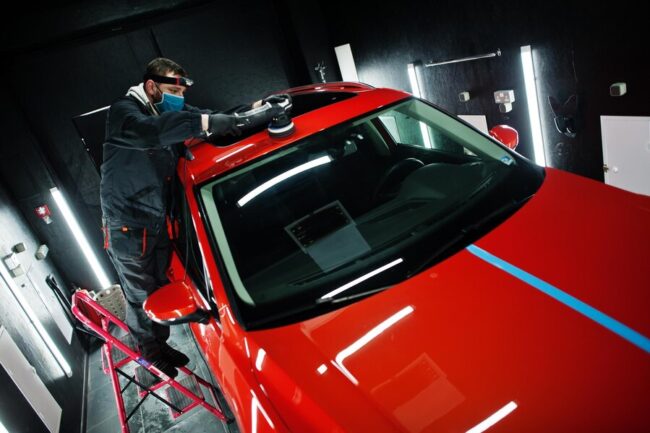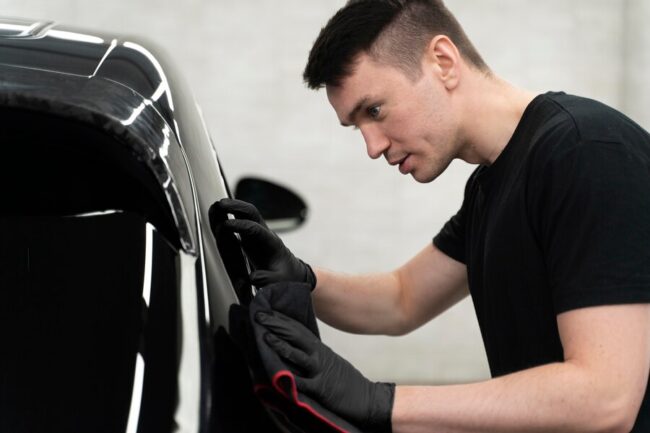As a car owner, you take pride in keeping your vehicle in top condition. However, one often overlooked threat to your car’s health is the relentless force of UV radiation from the sun. Long-term exposure to UV rays can wreak havoc on your car’s exterior and interior, leading to faded paint, cracked dashboard, and deteriorating rubber seals.
In this guide, we’ll explore the effects of UV radiation on your vehicle and provide practical tips to help you protect it from long-term UV damage. With the proper knowledge and preventive measures, you can keep your car looking and performing its best for years. Let’s dive in and shield your ride from the sun’s harmful rays.
Understanding UV Radiation
Understanding UV radiation is crucial for car owners looking to protect their vehicles from long-term damage. UV radiation consists of ultraviolet rays emitted by the sun, which can harm car surfaces over time. These rays are categorized into UVA, UVB, and UVC, with UVA being the most abundant and responsible for most damage to car exteriors and interiors.
UV rays can penetrate car windows, leading to fading, cracking, and deterioration of surfaces such as paint, plastics, rubber seals, and upholstery. By understanding the nature of UV radiation and its effects, car owners can take proactive measures to shield their vehicles and preserve their appearance and functionality.
How UV Radiation Affects Vehicle Surfaces And Materials
UV radiation can significantly impact vehicle surfaces and materials, causing gradual deterioration over time. The sun’s UV rays can penetrate the clear coat of car paint, leading to fading, discoloration, and loss of gloss.
This exposure can also weaken the molecular structure of plastics, rubber, and vinyl used in car interiors, leading to cracking, fading, and brittleness. Additionally, UV radiation can cause oxidation of metal surfaces, leading to corrosion and rust formation. Overall, prolonged exposure to UV radiation can visibly age a vehicle, diminishing its appearance and value.
Importance Of UV Protection For Both The Interior And Exterior Of The Car
UV protection is crucial for your car’s interior and exterior to maintain its aesthetics, functionality, and value over time. UV radiation can cause significant damage, leading to fading, cracking, and deterioration of interior surfaces like dashboards, seats, and trim. This impacts the visual appeal and compromises the structural integrity of these components.
Similarly, UV exposure can degrade exterior paint, leading to color fading and oxidation, which can be costly to repair. By implementing UV protection measures, such as window tinting and sunshades, and choosing UV-resistant materials, you can safeguard your car against these harmful effects, preserving its appearance and value for years.
 Signs Of UV Damage
Signs Of UV Damage
- Faded Paint: UV rays can cause the paint on your car to fade over time, especially on the hood, roof, and trunk. The once vibrant colors may become dull and lackluster.
- Cracked Dashboard: Excessive UV exposure can lead to the dashboard cracking and becoming brittle. This is often seen in older cars or vehicles that are frequently parked in direct sunlight.
- Deteriorated Upholstery: Leather and fabric upholstery can degrade under UV rays, leading to discoloration, fading, and tearing. This is particularly noticeable on seats and door panels.
- Brittle Rubber Seals: Rubber seals around windows, doors, and sunroofs can become brittle and crack due to UV exposure, leading to leaks and potential water damage.
- Peeling or Blistering Paint: In severe cases, UV damage can cause the paint to peel or blister, exposing the underlying metal to rust and corrosion.
- Discolored Trim and Plastic Parts: Exterior trim, bumpers, and other plastic parts can become discolored and chalky due to UV exposure, detracting from the overall appearance of the vehicle.
Preventive Measures
UV rays can wreak havoc on your car’s exterior and interior, leading to fading, cracking, and deterioration. Protect your vehicle with these preventive measures:
- Parking Strategies: Park your car in shaded areas whenever possible, such as under trees, in carports, or in covered parking garages. This reduces direct exposure to UV rays.
- Use of Car Covers: Invest in a high-quality car cover to shield your vehicle from UV rays. Look for covers that provide UV protection and are breathable to prevent moisture buildup.
- UV Protective Films or Coatings: Apply UV protective films or coatings to your car’s windows and windshield. These can significantly reduce UV penetration while maintaining visibility.
- Car Wax or Sealants: Regularly wax your car with a UV-resistant formula to create a protective barrier against UV rays. This helps maintain the shine of your paint and prevents fading.
- Interior Treatments: Use UV protectant sprays or covers for your dashboard, seats, and other interior components. This helps prevent cracking, fading, and other damage caused by UV exposure.
- Regular Maintenance: Keep your car clean and well-maintained to minimize the effects of UV damage. Regular washing and detailing can remove dirt and grime that can accelerate UV damage. Use interior cleaners and conditioners with UV protection to maintain the integrity of your interior surfaces.
Implementing these preventive measures can go a long way in protecting your car from long-term UV damage and preserving its appearance and value.
Strategies For Long-Term UV Protection
Regarding long-term UV protection for your car, several strategies can help shield your vehicle from the harmful effects of UV radiation. One effective method is window tinting, which enhances privacy and aesthetics and provides a barrier against UV rays. It’s essential to choose high-quality tint films that offer adequate UV protection. Additionally, sunshades for car covers when parking outdoors can significantly reduce UV exposure to your interior surfaces.
Opting for UV-resistant materials for your car’s upholstery and dashboard covers can also prevent fading, cracking, and deterioration caused by UV rays. Regular cleaning and conditioning using products with UV inhibitors can further protect your car from long-term UV damage, maintaining its appearance and value over time.
- Window tinting: Choose high-quality tint films with sufficient UV protection.
- Sunshades for car covers: Use these when parking outdoors to reduce UV exposure.
- UV-resistant materials: Opt for upholstery and dashboard covers to resist UV damage.
- Regular cleaning and conditioning: Use products with UV inhibitors to protect against fading and cracking.
- Professional installation: Ensure proper installation of window tinting and other UV protection measures for maximum effectiveness.
- Avoid prolonged sun exposure: Park in shaded areas whenever possible to minimize UV exposure to your car’s interior.
Maintenance Tips For UV Protection
Proper maintenance is crucial to ensure adequate UV protection for your car. Here are some essential tips:
- Regular Inspection: Periodically check your window tints for signs of damage or wear, such as peeling, bubbling, or discoloration. Promptly address any issues to maintain the integrity of the tint film’s UV protection.
- Cleaning and Conditioning: Regularly clean your car’s interior surfaces using products specifically designed for UV protection. For leather seats and dashboards, use a conditioner with UV inhibitors to prevent cracking and fading caused by UV exposure.
- UV Protectant Sprays: Consider using protective sprays or coatings on exposed surfaces like plastic trims, rubber seals, and vinyl interiors. These products provide an additional layer of protection against UV rays.
- Avoiding Harsh Cleaners: Use gentle pH-balanced cleaners formulated explicitly for automotive surfaces. Harsh chemicals can accelerate UV damage by stripping away protective layers.
- Shade and Cover: When parking your car outdoors, use sunshades or car covers to shield the interior from direct sunlight. This helps reduce UV exposure and minimizes the risk of fading and deterioration.
- Professional Maintenance: Schedule regular professional maintenance for your car, including UV protection checks and reapplication of UV protectant products as needed. Professional installation of window tints ensures proper coverage and longevity of UV protection.
By following these maintenance tips, you can prolong the life of your car’s interior and maintain its aesthetic appeal while effectively protecting it from UV damage.
 Additional Considerations
Additional Considerations
When considering long-term UV damage prevention for your car, it’s crucial to consider additional factors that can impact your vehicle’s exposure to UV radiation. Climate and geographical location play significant roles in the intensity and duration of UV exposure your car experiences. Areas with high temperatures and prolonged sunlight exposure may require more robust UV protection measures.
Additionally, it’s essential to adhere to consumer guidelines and regulations regarding using UV protection products for cars. Ensuring that these products meet industry standards will help you effectively make informed decisions about protecting your car from UV damage.
Conclusion
Protecting your car from long-term UV damage is essential for maintaining its appearance, comfort, and value. Understanding the harmful effects of UV radiation and implementing effective strategies can significantly extend the lifespan of your car’s interior and exterior.
Investing in window tinting with high UV protection levels, using sunshades for car covers, choosing UV-resistant materials for upholstery, and regular cleaning and conditioning can shield your car from fading, cracking, and deterioration caused by UV rays.
Additionally, staying mindful of climate and geographical factors that affect UV exposure, following maintenance tips for UV protection, and adhering to consumer guidelines for UV protection products can further enhance your car’s resilience against UV damage.
By taking these proactive measures, you not only preserve the aesthetics and functionality of your car but also contribute to its long-term durability and value retention. Make UV protection a priority in your car care routine, and enjoy a well-protected and vibrant vehicle for years to come.




